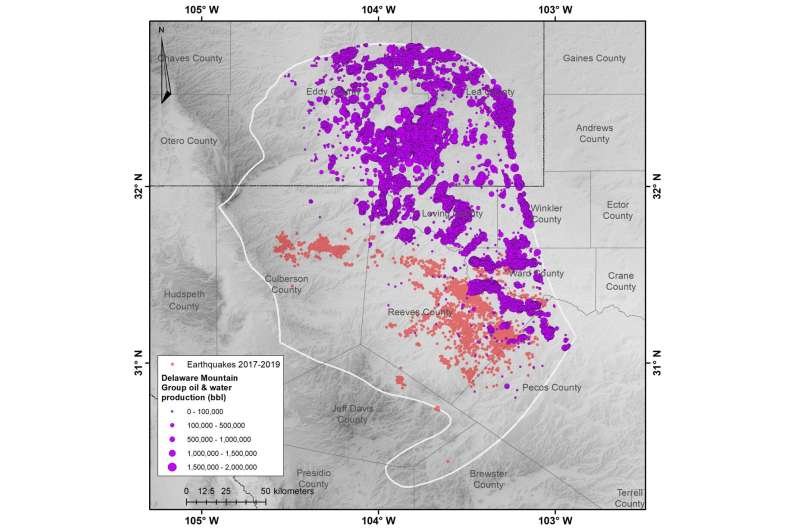Old oil fields may be less prone to induced earthquakes

Subsurface carbon sequestration—storing carbon inrocks deep underground—offers a partial solution for removing carbon fromthe atmosphere. Used alongside emissions reductions, geologic carbonsequestration could help mitigate anthropogenic climate change. But likeother underground operations, it comes with risks—including earthquakes.
Geophysicists are still working to understand what can triggerhuman-induced earthquakes, which have been documented since the 1960s. Anew study, published in Geology on Thursday, explores why part ofa heavily produced oilfield in the U.S. has earthquakes, and part of itdoesn't. For the first time, the authors demonstrate that the influence ofpast oil drilling changes stresses on faults in such a way that injectingfluids is less likely to induce, or trigger, earthquakes today.
The study focuses on the Delaware Basin, an oil- and gas-producing fieldspanning the border between West Texas and New Mexico. Drilling there hastaken place since at least the 1970s, with over 10,000 active individualwells dotting the region. There, Stanford geophysicists No'am Dvory andMark Zoback noticed an interesting pattern in seismic activity. Recentshallow earthquakes were mostly located in the southern half of the basin,while the northern half is seismically quiet, despite shallow wastewaterinjection occurring across the basin.
"The compelling question, then, is why are all the shallow earthquakeslimited to one area and not more widespread?" Zoback says.
Earthquakes can be induced by injecting fluids like wastewater underground.When wastewater is injected into the rocks, pressures increase, putting therocks and any faults that are present under higher stress. If thosepressures and stresses get high enough, an earthquake can happen.
Earthquakes from injection in the southern Delaware Basin tend to beshallow and relatively low-magnitude, typically strong enough to rattle thedishes, but not enough to cause damage. However, if deeper faults areactivated, higher-magnitude earthquakes can occur and cause damage. Forexample, in March 2020, a magnitude 4.6 earthquake rumbled in Mentone,Texas, likely due to deep injection that interacted with faults in thecrystalline basement rock around five miles belowground.
"The size of an earthquake is limited by the size of the fault that slips,"Dvory explains. Where faults are shallow and small (just a few kilometersin size), quake magnitudes tend to be small. "You can still feel it, butit's less dangerous."
Minimizing the risk of earthquakes is a goal for any subsurface operation,whether it's oil and gas production or carbon sequestration. That made theDelaware Basin, with its odd pattern of earthquakes, a great target forDvory and Zoback. It was a natural experiment in geomechanics, the "why"behind induced earthquakes.
To decipher the pattern, Dvory and Zoback first modeled the undergroundpressures needed to cause faults in the basin to slip and connected thosevalues to estimated stress values. Once they had established that baseline,they calculated the pore pressures around the Delaware Basin. Their resultsshowed a clear pattern: geologic formations in the northern basin wherehydrocarbons had previously been produced had lower pore pressures than in"unperturbed" rock, and there were no earthquakes. The southern basin,which had almost no previous production from the same formations, hadhigher initial pressures and earthquakes.
"In some areas we have evidence of oil and gas development from even the1950s," Dvory says. "Where there was significant hydrocarbon production,pressure was depleted, and the formations essentially became more stable."
Now, when fluids are injected back into those 'stable,' previously drilledrocks, the starting pressure is lower than the first time they weredrilled.
"So where oil production occurred previously, current injection results insignificantly lower pressure such that it's much less likely to triggerearthquakes," Zoback explains. "It's not inconceivable that at some point,if you injected enough, you could probably cause an earthquake. But here inthe area we study, we are able to document that what happened previouslystrongly affects how current operational processes affect the likelihood ofearthquake triggering."
Targeting these sites of past oil production, with their lower earthquakerisk, could be a good approach for carbon sequestration.
"We have a global challenge to store enormous volumes of carbon dioxide inthe subsurface in the next ten to twenty years," Zoback says. "We needplaces to safely store massive volumes of carbon dioxide for hundreds ofyears, which obviously includes not allowing pressure increases to triggerearthquakes. The importance of geoscience in meeting this challenge can'tbe overstated. It's an enormous problem, but geoscience is the criticalplace to start."
More information: Noam Z. Dvory et al, Prior oil and gas production can limit the occurrence of injection-induced seismicity: A case study in the Delaware Basin of western Texas and southeastern New Mexico, USA, Geology (2021). DOI: 10.1130/G49015.1
Journal information: Geology
Provided by Geological Society of America


















